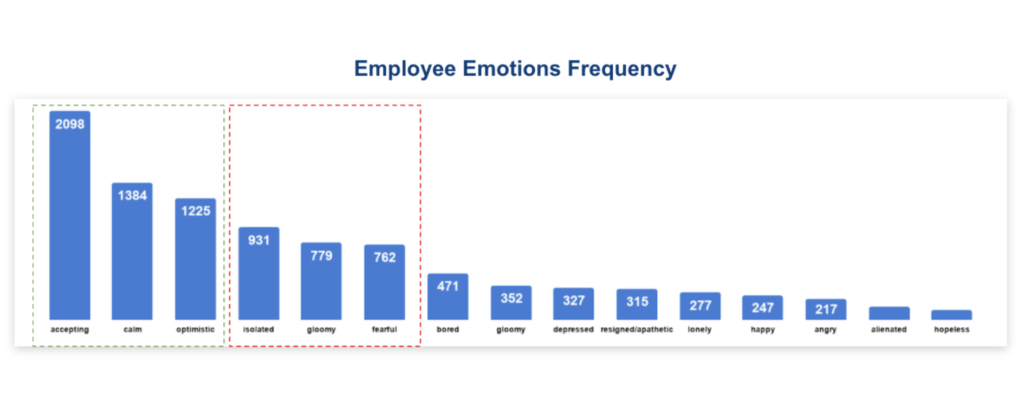Three Research-Backed EX Trends for Your Evolving Workplace
Adjusting to a remote working environment poses many challenges—it is this fact that led InMoment experts to get curious about the effect rapidly changing workplace conditions was having on employees. In true InMoment fashion, we surveyed thousands of employees globally to find the answers.
If you’re looking for reasons why employee experience (EX) is crucial to the success of your brand, all you need to do is count the hours. The truth is that most of us spend the majority of our lives at work; in many cases, we spend more time chatting with our co-workers than some of our family members. Therefore, the employee experience has a major impact on our overall health and well-being, leading us to look for jobs that both engage and fulfill us. This may be especially true now, as COVID-19 continues to change the way we work, and how our personal and professional lives continue to overlap.
It is this fact that led InMoment experts to get curious about the effect rapidly changing workplace conditions was having on employees. In true InMoment fashion, we surveyed thousands of employees globally to find the answers. The results led us to three eye-opening trends that all organizations should keep in mind as they continue to evolve their practices to keep up with the changing environment.
Trend #1: Employees Are Missing Connection
Adjusting to a remote working environment poses many challenges—especially when it comes to staying connected to colleagues. You can no longer pop by someone’s desk to ask about their weekend, or convene in the kitchen for a debrief on last night’s episode of a popular show. Yes, you can shoot someone a quick online message, but it’s just not the same as in-person discussions.
It is not surprising, then, that our survey found only 30% of remote workers felt a connection with coworkers. This is compared to the 36% of those who worked remotely prior to the pandemic—indicating that even in the best of times, remote work poses some challenges to personal connections. And the connection levels vary by age: the cohort that felt the highest levels of connection were the 18-24 yr olds, whereas the 25-44 age cohort scored the lowest on connection. There could be many reasons for this, not the least of which being that many in the older age group are more accustomed to fostering connections in-person, given that is likely the way they have always done it.
With the challenges to connecting, plus the fact that we are socially distanced in our personal lives as well, it’s no wonder that “isolation” was the highest endorsed negative emotion in the study.
There is a key opportunity here for companies to do more to help their employees feel connected to their coworkers. At InMoment, our teams have started hosting virtual trivia nights, happy hours, and coffee breaks to foster that connection despite being at a distance. Another idea is to organize virtual activities, such as running scavenger hunts, baking challenges, or book clubs. Sometimes, it’s simply just starting a discussion with team members on a topic unrelated to work, such as what people have been watching or how people are connecting with friends and family.
Trend #2: New Stressors Are Emerging
It’s no secret that integrating work and life pre-pandemic was already a struggle. Add in the lack of in-person schooling for kids, the inability to disconnect on a vacation, or simply the added stress inherent in a global health scare, and your employees are buried in stress. Our research showed that across all industries, employees were feeling the pressure of finding more ways to balance their personal and professional lives.
To help address these new stressors, it’s first important to acknowledge them. Encourage employees to share their concerns, and share your own. By listening to employees, you’ll understand each specific person’s situation better and be able to determine how best to address their challenges. Be flexible and willing to adapt, and your employees will appreciate the support—now and in the future.
Trend #3: Fear, Anxiety, and Loneliness Are Looming
Perhaps surprisingly, our initial study found emotional sentiment to be fairly positive for our respondents. Given that our initial research was conducted when the pandemic was in the early stages and people were still adjusting to remote working conditions, it makes sense that there was a novel sense of acceptance, calm, and even optimism.
However, below the surface of those emotions were deep concerns, as indicated in the qualitative responses. More negative emotions could be emerging and develop to primary emotions as the pandemic continues. While these rankings were similar across all demographics and working conditions, it will be interesting to see how this evolves as time goes on.
As leaders in an organization, you should keep these results in mind. While employees may at times seem positive and accepting, it’s important to still inquire regularly about their emotional well-being. It’s okay to allow employees to vent a little bit or share their concerns—in the long run, this will help you proactively address any issues or concerns.
So What’s Next?
It’s important to note the findings summarized here are from earlier in the pandemic. Now, 5 months in, sentiment and feelings will likely have changed slightly. People may be getting used to their new working environments and schedules, and they may have new ways to connect with coworkers.
However, as we’ve seen, this pandemic continues to throw many of us for a loop. There are even bigger decisions to be made in the coming weeks and months, and it’s hard to know how new developments will impact us personally and professionally. Using this report to understand employees’ initial sentiment on how organizations are handling the pandemic provides a baseline and roadmap you can reference to move forward.
It’s safe to assume stress and loneliness will continue to evolve. Employees need your support more than ever!
About the Study:
Over 2700 employees across 17 organizations participated in the remote worker survey. 61% of the respondents were new to working from home. 89% were from north america, with the majority (54%) in the 25-44 yr old age range. The population had a mix of individuals who were with their company for 10 or more years (23%), and new employees (<3yrs) represented 20%.

